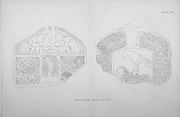
Nigg Stone
Encyclopedia


Pictish stones
Pictish stones are monumental stelae found in Scotland, mostly north of the Clyde-Forth line. These stones are the most visible remaining evidence of the Picts and are thought to date from the 6th to 9th centuries, a period during which the Picts became Christianized...
, perhaps dating to the end of the 8th century. The stone was originally located at the gateway to the grounds of the parish church
Parish church
A parish church , in Christianity, is the church which acts as the religious centre of a parish, the basic administrative unit of episcopal churches....
of Nigg
Nigg, Highland
Nigg is a village and parish on the north east shore of Nigg Bay in north east Ross-shire and is in the Scottish council area of Highland...
, Easter Ross
Easter Ross
Easter Ross is a loosely defined area in the east of Ross, Highland, Scotland.The name is used in the constituency name Caithness, Sutherland and Easter Ross, which is the name of both a British House of Commons constituency and a Scottish Parliament constituency...
. It is one of the finest surviving Pictish carved stones, and one of the most elaborate carved stones surviving from early medieval Europe. It is now displayed, restored to its original proportions, in a room inside the parish church (open in summer; key kept locally). It bears an elaborately decorated cross
Cross
A cross is a geometrical figure consisting of two lines or bars perpendicular to each other, dividing one or two of the lines in half. The lines usually run vertically and horizontally; if they run obliquely, the design is technically termed a saltire, although the arms of a saltire need not meet...
in high relief on the 'front' and a figural scene on the reverse. This scene is extremely complicated and made more difficult to interpret by deliberate defacement. Among the depictions are two Pictish symbols: an eagle
Eagle
Eagles are members of the bird family Accipitridae, and belong to several genera which are not necessarily closely related to each other. Most of the more than 60 species occur in Eurasia and Africa. Outside this area, just two species can be found in the United States and Canada, nine more in...
above a Pictish Beast
Pictish Beast
The Pictish Beast is an artistic representation of an animal, and is depicted on Pictish symbol stones. It is not easily identifiable with any real animal, but resembles a seahorse, especially when depicted upright...
, a sheep, the oldest evidence of a European triangular harp
Harp
The harp is a multi-stringed instrument which has the plane of its strings positioned perpendicularly to the soundboard. Organologically, it is in the general category of chordophones and has its own sub category . All harps have a neck, resonator and strings...
, and hunting scenes. Scholars interpret the scene as representing a story of the biblical King David
David
David was the second king of the united Kingdom of Israel according to the Hebrew Bible and, according to the Gospels of Matthew and Luke, an ancestor of Jesus Christ through both Saint Joseph and Mary...
. The carvings on the cross side show close similarities to the contemporary high crosses of Iona
Iona
Iona is a small island in the Inner Hebrides off the western coast of Scotland. It was a centre of Irish monasticism for four centuries and is today renowned for its tranquility and natural beauty. It is a popular tourist destination and a place for retreats...
. These works may indeed have been created by the same 'school' of carvers, working for different patrons. The stone was shattered in the 18th century. The upper and lower parts were crudely joined together using metal staples (now removed), and the shattered intervening part was discarded. Part of the missing fragment was recovered in 1998 by Niall M Robertson, in the stream which runs below the mound on which the churchyard is set, having probably been thrown down the bank at the time the slab was 'repaired'. This small fragment shows most of the 'Pictish beast' symbol, and is currently preserved in Tain
Tain
Tain is a royal burgh and post town in the committee area of Ross and Cromarty, in the Highland area of Scotland.-Etymology:...
Museum.
External links
- Am Baile
- Strathclyde University STAMS Pictish Stone Search Facility.
- Nigg Old Trust

